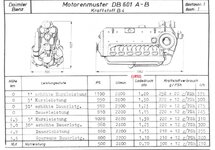Shortround6
Lieutenant General
the main problem is finding enough DB 601 engines.
You can't stop cut into production of the 109s, you don't have enough of them to begin with.
You can't cut the 110 out completely, you need the big wing and big cockpit for certain jobs.
The MG/FF drums are a problem but building and using 90-100 round drums is not that big a deal (gun breeches and drums may have to go behind the cockpit. 60 rounds is too few, 180 rounds for the MG/FF may be overkill. Get the crew working on the MG 151 to take coffee breaks only (no strudel) to speed things up.
Manual for the early P-38s shows the following for the P-38D & E at 12,000ft. and using 260 (US) gallons (40gal used up in start, warm up, take off)
max continuous power 2600rpm......38in........180gph (US)...........345mph...............450 miles
1 step down.......................2300rpm.....31in.........114gph....................310mph...............630 miles
4th step down...................2100rpm.....27in...........72gph....................265mph...............860 miles
Most economic.................1700rpm.....22in...........61gph.....................230mph.............870 miles
Chart says the distances are for 12,000ft only which is one reason I used those speeds and throttle settings. The other is that while the turbos were working they wouldn't be working that much.
Take-off and climb chart (at 15,000lbs/6,800kg?) ) says 41 gallons to get to 10,000ft from sea level using 2300rpm and 29in.
We have the usual US cross over on the flight operation instruction chart (fuel used for start includes climbing to 5,000ft) and the climb chart (fuel used is from sea level but flying.
There are charts for the P-38F and P-38G but I figured the D & E were going to be closer to the early DB 601 engines.
You can't stop cut into production of the 109s, you don't have enough of them to begin with.
You can't cut the 110 out completely, you need the big wing and big cockpit for certain jobs.
The MG/FF drums are a problem but building and using 90-100 round drums is not that big a deal (gun breeches and drums may have to go behind the cockpit. 60 rounds is too few, 180 rounds for the MG/FF may be overkill. Get the crew working on the MG 151 to take coffee breaks only (no strudel) to speed things up.
Manual for the early P-38s shows the following for the P-38D & E at 12,000ft. and using 260 (US) gallons (40gal used up in start, warm up, take off)
max continuous power 2600rpm......38in........180gph (US)...........345mph...............450 miles
1 step down.......................2300rpm.....31in.........114gph....................310mph...............630 miles
4th step down...................2100rpm.....27in...........72gph....................265mph...............860 miles
Most economic.................1700rpm.....22in...........61gph.....................230mph.............870 miles
Chart says the distances are for 12,000ft only which is one reason I used those speeds and throttle settings. The other is that while the turbos were working they wouldn't be working that much.
Take-off and climb chart (at 15,000lbs/6,800kg?) ) says 41 gallons to get to 10,000ft from sea level using 2300rpm and 29in.
We have the usual US cross over on the flight operation instruction chart (fuel used for start includes climbing to 5,000ft) and the climb chart (fuel used is from sea level but flying.
There are charts for the P-38F and P-38G but I figured the D & E were going to be closer to the early DB 601 engines.

